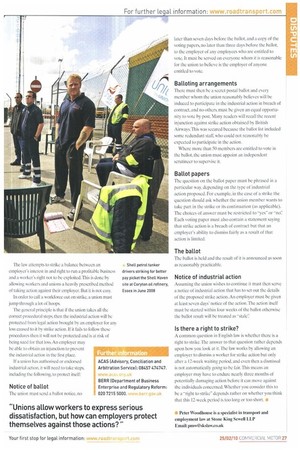Union recognition can bring benefits, but in the event of
Page 26

Page 27

If you've noticed an error in this article please click here to report it so we can fix it.
a dispute, both sides should be aware of the requirements to fulfil before any action can take place.
Words: Peter Woodhouse Across the UK, the labour market is uncertain. Some say the recession is over, some fear the dreaded double dip. There is also an election looming. If you add to that the perennial transport industry problems of rising fuel costs and operators who will do jobs at less than cost, it should come as no surprise that there remains a deep nervousness in the labour market.
The bigger the workforce, the more collective workforce issues there are likely to be. If a majority agrees, a workforce has a right to have a trade union recognised for the purposes of collective bargaining.
The larger the operator, the more likely it is that a union will be involved within the workforce.
If a union gets interested in a new or growing operator, it will usually canvass the attitude of management towards recognition, and if not satisfied with the response. will issue a formal request for recognition.
The law gives basic rights to bargain in relation to pay, hours and holidays it can sometimes be in all parties' interests to negotiate on the contents of a collective agreement, since each side may get more by doing so. Once a union obtains recognition, its rights will usually be set out in a collective agreement.
It is important for both sides that such agreements are carefully drafted. Although they are not usually legally binding, unions can respond to an operator's breach with industrial action. A union can and often does facilitate proper communication in the workplace, but its involvement means that employees are able to legally organise industrial action.
.[he law attempts to strike a balance between an employer's interest in and right to run a profitable business and a worker's right not to be exploited This is done by allowing workers and unions a heavily prescribed method of taking action against their employer. But it is not easy.
In order to call a workforce out on strike, a union must jump through a lot of hoops.
The general principle is that if the union takes all the correct procedural steps, then the industrial action will be protected from legal action brought by an employer for any loss caused to it hy strike action. If it fails to follow these procedures then it will not be protected and is at risk of being sued for that loss. An employer may be able to obtain an injunction to prevent the industrial action in the first place.
If a union has authorised or endorsed industrial action, it will need to take steps, including the following, to protect itself: later than seven days before the ballot, and a copy of the voting papers, no later than three days before the ballot, to the employer of any employees who are entitled to vote. It must be served on everyone whom it is reasonable for the union to believe is the employer of anyone entitled to vote.
Balloting arrangements
There must then be a secret postal ballot and every member whom the union reasonably believes will be induced to participate in the industrial action in breach of contract, and no others, must be given an equal opportunity to vote by post. Many readers will recall the recent injunction against strike action obtained by British Airways. This was secured because the ballot list included some redundant staff, who could not reasonably be expected to participate in the action.
Where more than 50 members are entitled to vote in the ballot, the union must appoint an independent scrutineer to supervise it.
Ballot papers
The question on the ballot paper must be phrased in a particular way. depending on the type of industrial action proposed. For example, in the case of a strike the question should ask whether the union member wants to take part in the strike or its continuation (as applicable). The choices of answer must be restricted to "yes" or "no': Each voting paper must also contain a statement saying that strike action is a breach of contract but that an employer's ability to dismiss fairly as a result of that action is limited.
The ballot
The ballot is held and the result of it is announced as soon as reasonably practicable.
Notice of industrial action
Assuming the union wishes to continue it must then serve a notice of industrial action that has to set out the details of the proposed strike action. An employer must be given at least seven days' notice of the action. The action itself must be started within four weeks of the ballot otherwise the ballot result will he treated as "stale':
Is there a right to strike?
A common question in English law is whether there is a right to strike. The answer to that question rather depends upon how you look at it. The law works by allowing an employer to dismiss a worker for strike action but only after a 12-week waiting period, and even then a dismissal is not automatically going to be fair. This means an employer may have to endure nearly three months of potentially damaging action before it can move against the individuals concerned. Whether you consider this to be a "right to strike" depends rather on whether you think that this 12-week period is too long or too short. tr




































































































































